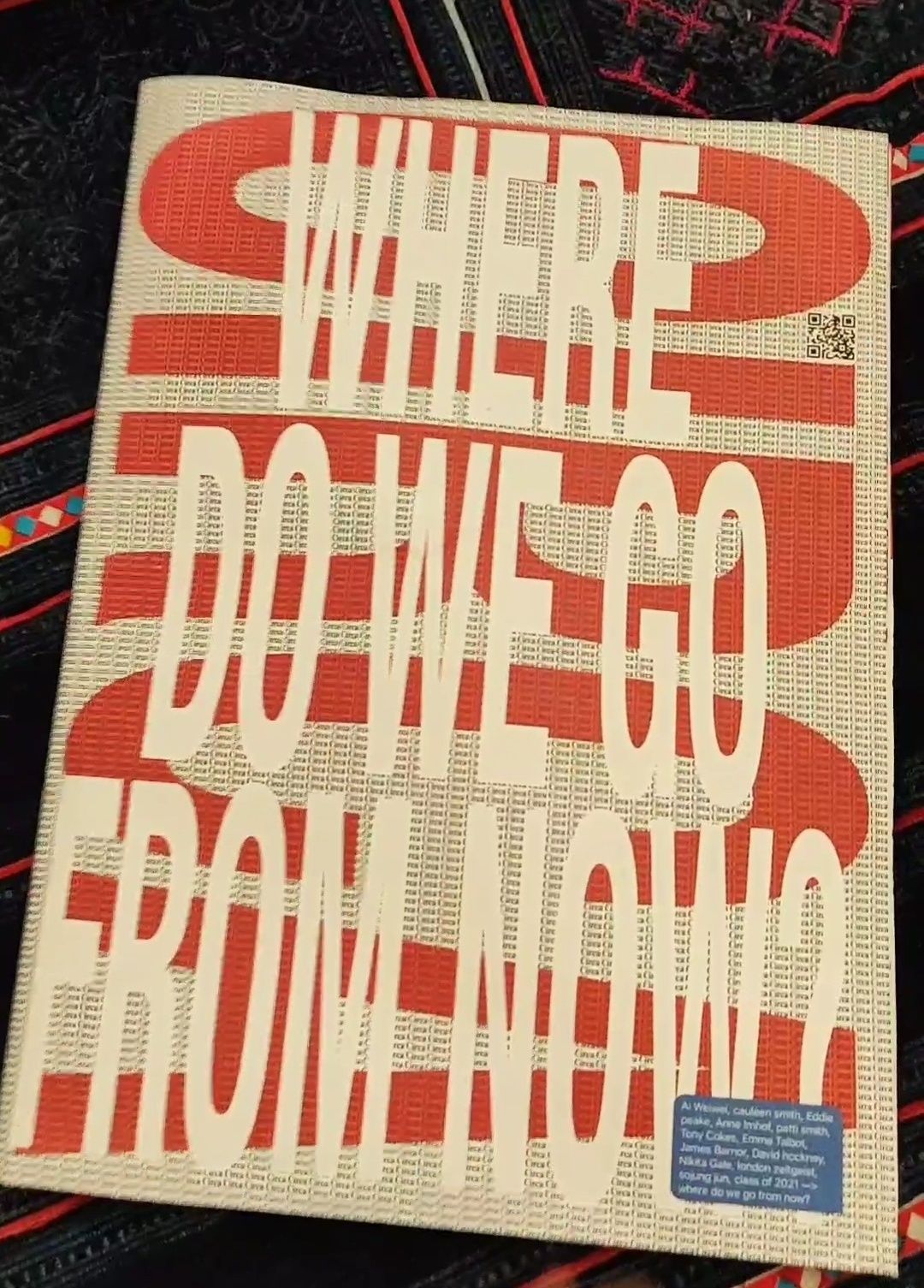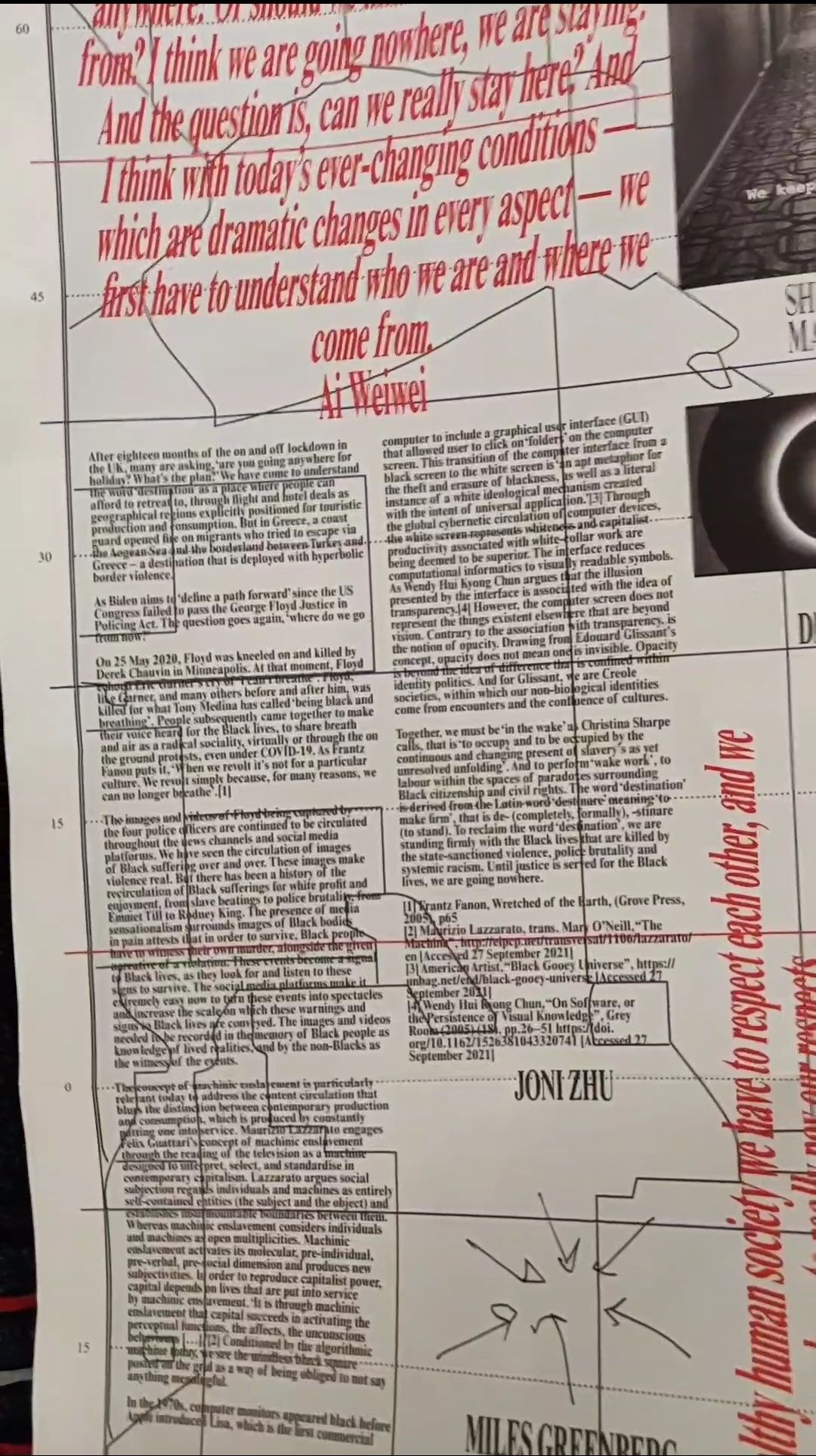In the lead up to COP26, CIRCA dedicated their global art and culture platform to a month-long public investigation of the urgent question ‘WHERE DO WE GO FROM NOW?’, featuring key responses from artists, writers, thinkers and various cultural leaders. The project harnesses today’s global moment of unpredictable flux to propose routes toward more inclusive, more creative and fairer societies, placing a focus on the shared “now” of this unique post-crisis moment, rather than the divided “here” of our individual circumstances.
Destination, Circulation, Where Are We Going?
By Joni Zhu
After eighteen months of the on and off lockdown in the UK, many are asking, ‘are you going anywhere for holiday? What’s the plan?’ We have come to understand the word ‘destination’ as a place where people can afford to retreat to, through flight and hotel deals as geographical regions explicitly positioned for touristic production and consumption. But in Greece, a coast guard opened fire on migrants who tried to escape via the Aegean Sea and the borderland between Turkey and Greece – a destination that is deployed with hyperbolic border violence.
As Biden aims to ‘define a path forward’ since the US Congress failed to pass the George Floyd Justice in Policing Act. The question goes again, ‘where do we go from now?’
On 25 May 2020, Floyd was kneeled on and killed by Derek Chauvin in Minneapolis. At that moment, Floyd echoed Eric Garner’s cry of ‘I can’t breathe’. Floyd, like Garner, and many others before and after him, was killed for what Tony Medina has called ‘being black and breathing’. People subsequently came together to make their voice heard for the Black lives, to share breath and air as a radical sociality, virtually or through the on the ground protests, even under COVID-19. As Frantz Fanon puts it, ‘When we revolt it’s not for a particular culture. We revolt simply because, for many reasons, we can no longer breathe’.[1]
The images and videos of Floyd being captured by the four police officers are continued to be circulated throughout the news channels and social media platforms. We have seen the circulation of images of Black suffering over and over. These images make violence real. But there has been a history of the recirculation of Black sufferings for white profit and enjoyment, from slave beatings to police brutality, from Emmet Till to Rodney King. The presence of media sensationalism surrounds images of Black bodies in pain attests that in order to survive, Black people have to witness their own murder, alongside the given narrative of a violation. These events become a signal to Black lives, as they look for and listen to these signs to survive. The social media platforms make it extremely easy now to turn these events into spectacles and increase the scale on which these warnings and signs to Black lives are conveyed. The images and videos needed to be recorded in the memory of Black people as knowledge of lived realities, and by the non-Blacks as the witness of the events.
The concept of machinic enslavement is particularly relevant today to address the content circulation that blurs the distinction between contemporary production and consumption, which is produced by constantly putting one into service. Maurizio Lazzarato engages Félix Guattari’s concept of machinic enslavement through the reading of the television as a machine designed to interpret, select, and standardize in contemporary capitalism. Lazzarato argues social subjection regards individuals and machines as entirely self-contained entities (the subject and the object) and establishes insurmountable boundaries between them. Whereas machinic enslavement considers individuals and machines as open multiplicities. Machinic enslavement activates its molecular, pre-individual, pre-verbal, pre-social dimension and produces new subjectivities. In order to reproduce capitalist power, capital depends on lives that are put into service by machinic enslavement. ‘It is through machinic enslavement that capital succeeds in activating the perceptual functions, the affects, the unconscious behaviours […].’[2] Conditioned by the algorithmic machine today, we see the mindless black square posted on the grid as a way of being obliged to not say anything meaningful.
In the 1970s, computer monitors appeared black before Apple introduced Lisa, which is the first commercial computer to include a graphical user interface (GUI) that allowed users to click on ‘folders’ on the computer screen. This transition of the computer interface from a black screen to a white screen is ‘an apt metaphor for the theft and erasure of blackness, as well as a literal instance of a white ideological mechanism created with the intent of universal application.’[3] Through the global cybernetic circulation of computer devices, the white screen represents whiteness and capitalist productivity associated with white-collar work are being deemed to be superior. The interface reduces computational informatics to visually readable symbols. Wendy Hui Kyong Chun argues that the illusion presented by the interface is associated with the idea of transparency.[4] However, the computer screen does not represent the things existent elsewhere that are beyond vision. Contrary to the association with transparency is the notion of opacity. Drawing from Édouard Glissant’s concept, opacity does not mean one is invisible. Opacity is beyond the idea of difference that is confined within identity politics. And for Glissant, we are Creole societies, within which our non-biological identities come from encounters and the confluence of cultures.
Together, we must be ‘in the wake’ as Christina Sharpe calls, that is ‘to occupy and to be occupied by the continuous and changing present of slavery’s as yet unresolved unfolding’. And to perform ‘wake work’, to labour within the spaces of paradoxes surrounding Black citizenship and civil rights. The word ‘destination’ is derived from the Latin word ‘destinare’ meaning ‘to make firm’, that is de- (completely, formally), -stinare (to stand). To reclaim the word ‘destination’, we are standing firmly with the Black lives that are killed by the state-sanctioned violence, police brutality and systemic racism. Until justice is served for the Black lives, we are going nowhere.
[1] Frantz Fanon, Wretched of the Earth, (Grove Press, 2005), p65
[2] Maurizio Lazzarato, trans. Mary O’Neill, “The Machine”, http://eipcp.net/transversal/1106/lazzarato/en [Accessed 27 September 2021]
[3] American Artist, “Black Gooey Universe”, https://unbag.net/end/black-gooey-universe [Accessed 27 September 2021]
[4] Wendy Hui Kyong Chun, “On Software, or the Persistence of Visual Knowledge”, Grey Room (2005) (18), pp.26–51 https://doi.org/10.1162/1526381043320741 [Accessed 27 September 2021]

